When we talk about nanotechnology, it often sounds like something futuristic or far away. But in reality, this science is already helping deliver active ingredients deeper and more precisely — straight to the root of your hair. 🌱
In our previous posts, we explored how nanocarriers can enhance treatments like minoxidil.
But there’s still one big question:
How do these tiny particles actually reach the follicle? 🤔
In this article, you’ll discover:
- the natural pathways into the follicle 🛤️
- what a nanocarrier must overcome to get there 🧱
- and why all of this means better results with fewer side effects — for you. ✅
🧬 Inside the Follicle: Why It’s So Hard to Reach
On the surface, it sounds simple: apply a topical treatment, it sinks in, and supports hair growth.
But in reality, human skin is brilliantly designed to keep things out, not let them in. 🛡️
That’s why most active ingredients stay on the surface, and only a small amount manages to reach the follicle — where the real action happens. ⚙️
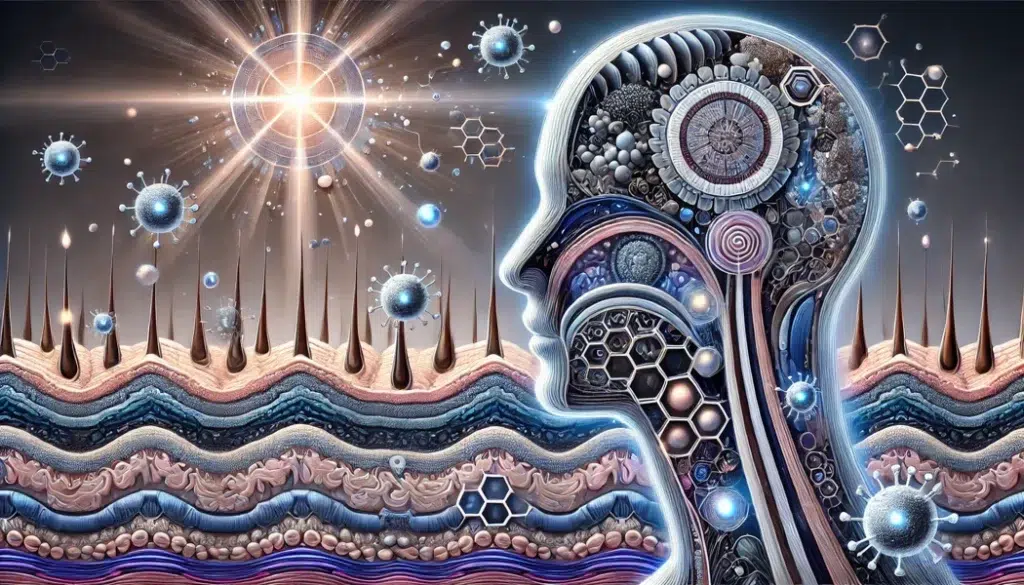
🔍 So what’s standing in the way?
Your hair follicle sits deep beneath the skin, and reaching it means going through:
- narrow sebaceous ducts (tiny oil channels near each hair) 🌀
- the outermost protective barrier called the stratum corneum 🧱
- and layers of fat and tissue 🧬
Even the best ingredients can get stuck at the surface — and never reach their true target (PubMed), (Wiley Online Library).
✅ Why does this matter for you?
Because if the ingredient doesn’t reach your follicle, even the most promising treatments — like minoxidil, caffeine, or plant-based compounds — can’t do their job properly.
That’s why scientists developed nanocarriers: ultra-small, flexible particles designed to slip through those barriers and go straight to the root. 🎯
🧠 Think of them like microscopic delivery drivers who know exactly where to go — and won’t stop until they reach the base of your hair. 🚚
🚪 The Follicular Route: A Natural Gateway for Nanocarriers
Your skin is built like a fortress — but hair follicles are like hidden doorways. 🚪
And for nanocarriers, those doorways are wide open.
Unlike the flat, tightly packed cells on the outer layer of your skin, follicles are natural openings that go deep into the scalp.
They’re not just where hair grows — they’re also where ingredients have the best chance to sneak in.
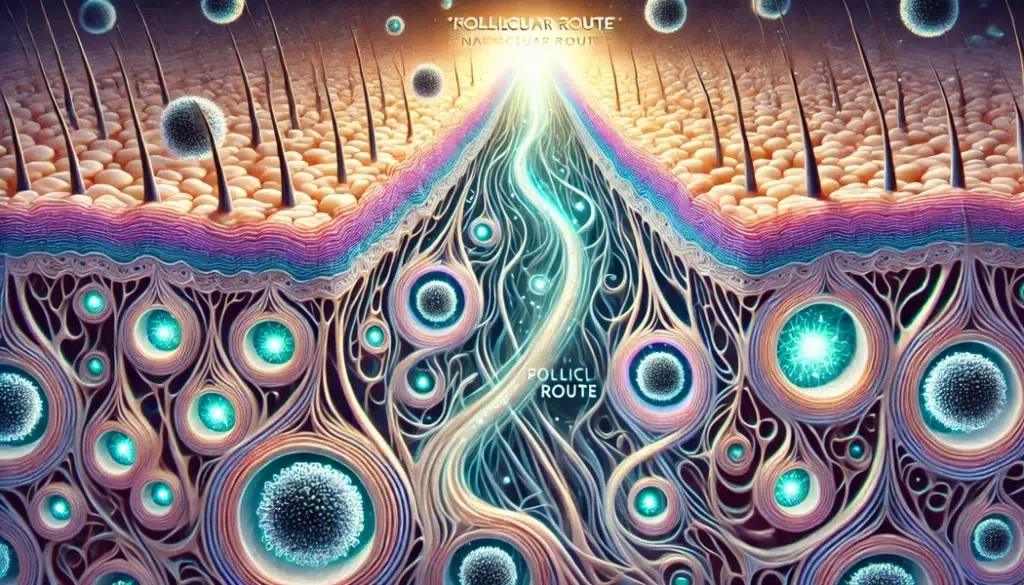
📌 Why follicles matter for absorption:
- Hair follicles cover up to 10% of the skin’s surface
- Each follicle is surrounded by sebaceous glands that create a tiny, oil-lined tunnel
- That tunnel — called the sebaceous duct — can act as a shortcut into deeper skin layers 🛤️
🧠 In other words: while most creams and serums struggle to get through the skin’s outer layer, nanocarriers can take the back door — straight through the follicle.
🔬 What makes this route so effective?
Scientists have found that:
- Transfollicular absorption (through the follicle) can be up to 10× more efficient than absorption through the flat skin surface (PubMed)
- This pathway avoids some of the toughest skin barriers, allowing more of the active ingredient to actually reach its target
💡 This means better penetration, faster results, and potentially lower doses — all because we’re using the body’s own architecture in a smarter way.
⚙️ Key Factors That Control Penetration
Not every nanocarrier is created equal. To pass through the follicle’s tiny “tunnels” and reach the root, particles need the right design — a bit like building the perfect key for a very small lock. 🔑
🔬 The main factors that matter:
- Size — the sweet spot is usually 50–200 nanometers. Too big, and the particles get stuck; too small, and they might slip away without releasing enough of the active ingredient.
- Shape — spherical or flexible particles move more easily through the winding follicle canal than rigid ones. Think of a marble rolling smoothly compared to a sharp-edged cube. ⚪
- Surface charge (zeta potential) — a balanced charge helps nanocarriers stick just enough to the follicle walls without causing irritation. Too positive = possible redness, too negative = poor attachment.
- Hydrophilic vs. hydrophobic balance — the outer layer of the skin is oily, while deeper layers are more watery. Nanocarriers that can “adapt” to both environments travel further. 🌊
(Wiley Online Library), (PubMed).
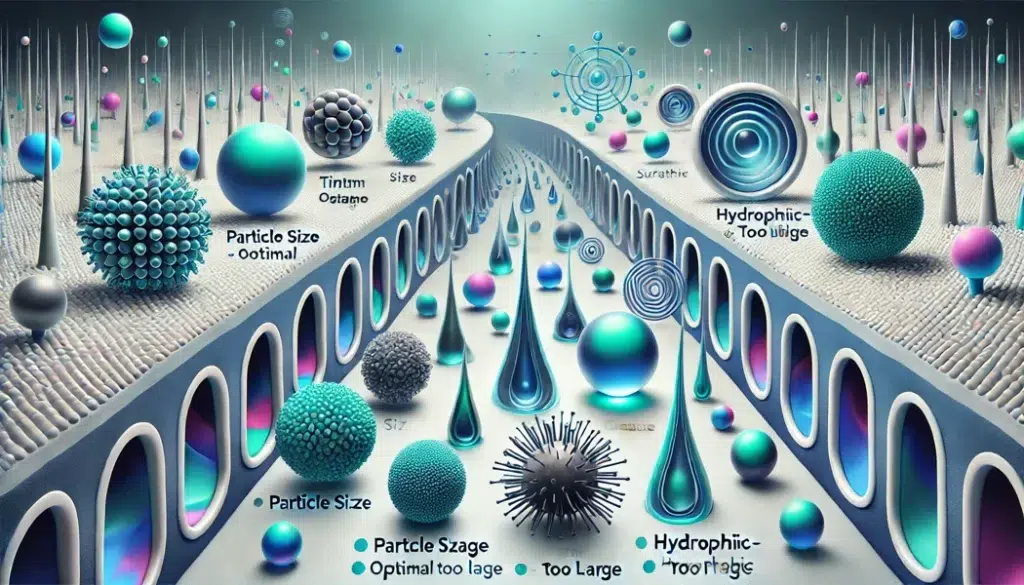
✅ Why does this matter for you?
When scientists fine-tune these properties, the result is maximum delivery with minimum waste.
That means:
- More active ingredients actually reach your follicles
- You don’t need heavy doses to see an effect
- Less risk of irritation or side effects 🚫
🧠 In short: smarter design = stronger, safer results for your hair.
🎯 Smart Delivery: How Nanocarriers Find Their Target
Getting into the follicle is just the first step. The real magic happens when nanocarriers know exactly where to drop off their “cargo.”
Scientists are now designing smart nanocarriers that don’t just wander randomly — they’re built to recognize the right spot and release their ingredients only when needed.
🔑 How does this work?
- Passive targeting → particles naturally slide into the follicle thanks to their small size and shape
- Active targeting → some nanocarriers are coated with ligands (tiny “tags”) that act like GPS signals, guiding them to specific cells in the hair root
- Stimuli-responsive systems → new designs can react to local changes in pH, enzymes, or temperature, so they open and release treatment only inside the follicle 🔓
(Science Direct), (PubMed)
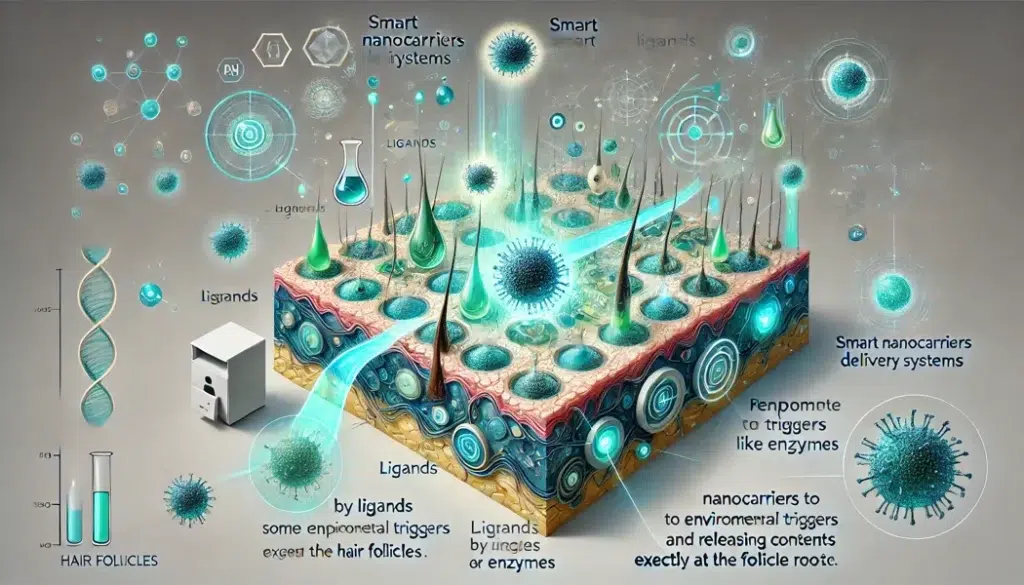
✅ What does this mean for you?
- More precision — active ingredients go right where your follicles need them most
- Less waste — no flooding your whole scalp or bloodstream unnecessarily
- Gentler care — fewer side effects, more natural balance 🌿
🧠 Think of it as upgrading from dropping leaflets all over town…
➡️ to sending a personal letter straight into the right mailbox.
💥 Efficiency Over Quantity: The Power of Precise Delivery
In hair care, more isn’t always better.
Sometimes, what really works is not a higher dose — but a smarter one.
Thanks to nanocarriers, we can now target the follicle directly and use less product to get better results.
It’s like switching from spraying a whole room with air freshener…
➡️ to placing one perfect scent where it matters. 🌬️
📉 Why this is a big deal:
- Traditional treatments often sit on the scalp, hoping a small amount will sink in
- That leads to higher concentrations, more side effects, and slower progress
- Nanocarriers flip that script — they bring the ingredient right to the follicle, so you need less to achieve more
(ScienceDirect), (PubMed)
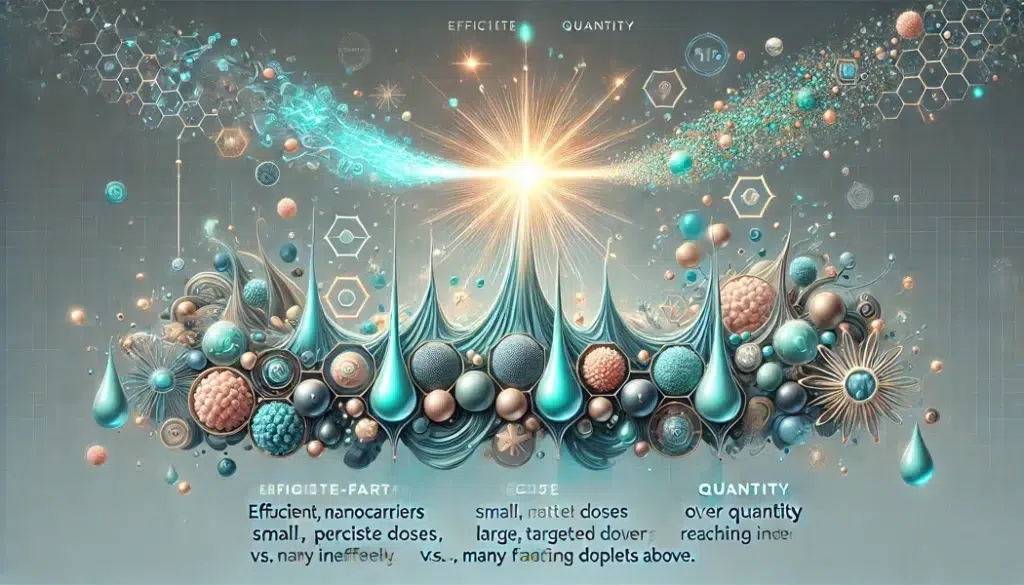
✅ What’s the benefit for you?
- Smaller doses → less risk of irritation, especially for sensitive scalps
- Faster visible effects → because the active compound goes straight to the source
- Lower overall exposure → better for your body, your wallet, and your peace of mind
🧠 Imagine getting the same or better results —
➡️ without the guesswork, the side effects, or the wait.
🔄 What Happens After Delivery? Fate of Nanoparticles
So, the nanocarrier reaches the follicle. It delivers the active compound.
But then what? Does it just… stay there? 🧐
It’s a great question — and a very important one.
♻️ Here’s what usually happens:
- Most nanocarriers are made from biodegradable materials like lipids or polymers
- Once they’ve released their “cargo,” the body naturally breaks them down using enzymes or pH-sensitive reactions
- The leftover fragments are either absorbed safely, expelled through the skin, or eliminated by normal metabolic processes 🧬
⚠️ What about safety?
🧠 The good news: Research shows that properly designed nanocarriers — especially those used in cosmetics and dermatology — are unlikely to reach the bloodstream in significant amounts when applied topically.
They mostly stay within the upper skin layers or follicles, and are gradually broken down or expelled (ScienceDirect), (PubMed)
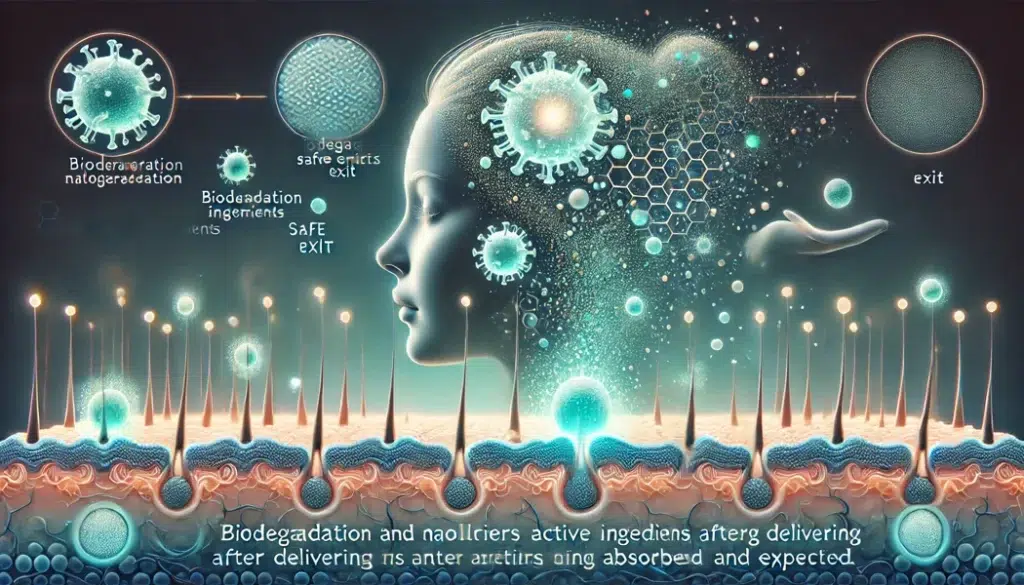
That means:
- Low risk of systemic side effects
- No long-term buildup in the body
- Generally safe for regular use, when formulated correctly ✅
✅ What’s the takeaway for you?
You get the precision and power of nanotech,
👉 without flooding your whole system
👉 and without lingering materials that don’t belong in your body
It’s targeted care — and it leaves quietly once the job is done. 🕊️
🌿 Expert-Recommended Holistic Hair Growth Package
If you want real results and natural care for your hair, we’ve selected three proven allies from a sea of options — chosen because their effectiveness is backed by science and experience:
🧴 Specially formulated shampoo — made with natural ingredients that act as powerful DHT blockers, keeping follicles protected. 👉 Learn more
💆♂️ Nutrient-rich conditioner — packed with botanical extracts that strengthen hair at the root and, together with the shampoo, form a double defense against DHT. 👉 Discover here
🌱 Anti-stress supplement — balances cortisol and supports your body from the inside out, because healthy hair starts within. 👉 See details

⚡ Pro Tip: The effects of this package can be even further amplified when paired with low-level laser therapy (LLLT) — a combination that stimulates circulation and maximizes follicle response.
🧭 Bridging the Gap: From Lab to Real-World Treatments
That way, when nanocarrier-based solutions arrive — your follicles are already primed and ready. Emerging nanotherapies promise not only stronger but also lasting effects — unlike current options that often deliver only temporary results. But here’s the catch: these breakthroughs will work best if we prepare our scalp and body in advance. By entering this new era with healthier follicles and a balanced system, we’ll maximize the benefits of what’s coming. That’s why it’s more important than ever to get ready now — so when nanotherapies, which are already knocking at your door, become widely available, your hair and your whole body will be primed to respond.
🥦 A balanced and nutrient-rich diet provides the essential building blocks for stronger hair.
🌬️ Regular time spent in fresh air and avoiding polluted environments helps reduce oxidative stress that damages follicles.
🏃 Moderate physical activity improves circulation and delivers oxygen to the scalp.
🧘 Avoiding stressful situations supports hormonal balance and protects the natural hair cycle, as explained in Adaptogens, Hair Loss and Stress.
🚭 Quitting smoking and limiting alcohol intake help preserve microcirculation and reduce toxins in the body.
🍔❌ Cutting down on junk food prevents inflammation and keeps blood sugar levels stable.
💧 Drinking pure water instead of sugary or carbonated beverages maintains hydration, which is essential for healthy hair growth.

🚀 What’s Next?
This is just the beginning of our journey into the world of nanotechnology and hair health. 🌱🔬
In the upcoming posts, we’ll share fresh scientific insights and introduce you to the first nanotechnology-based products hitting the market soon. 🧴✨
👉 Stay tuned and follow along so you’ll be among the first to know what’s coming — and how to combine it with a holistic approach for maximum hair regrowth.
Because healthy hair isn’t just a goal — it’s a journey. 💪💧
👉 Visit the About Me page to learn more about my journey, mission, and why helping people with hair health is so personal to me.
Want healthier, stronger hair? Discover 8 science-backed habits that protect your scalp and boost natural growth. Get your free PDF guide today!
Some links in this article are affiliate links. If you choose to make a purchase through them, I may earn a small commission at no extra cost to you — helping me keep HairGrowGenius running. Thank you for your support!

❓ Frequently Asked Questions
🤔 How is transfollicular delivery different from regular topical absorption?
Transfollicular delivery uses the natural opening of the hair follicle — almost like a tunnel — to bypass the thick outer layers of the skin. Regular topical absorption struggles to get through those barriers, which means many active ingredients never reach the root. By using the follicular route, nanocarriers can go deeper, faster, and more precisely.
🧴 Are these nanocarrier systems already available in everyday hair products?
Not yet — at least not in their most advanced form. Most current products still rely on basic formulations. However, some companies are starting to use early versions of nano-based delivery, and the science is moving fast. That’s why preparing your scalp now with supportive, research-backed products makes a lot of sense.
⚡ Do smaller doses really work better with nanocarriers?
Yes. Because nanocarriers deliver ingredients exactly where they’re needed, you often need less to see the same or even better results. This reduces the risk of irritation and makes the whole treatment process gentler and more efficient — especially for people with sensitive skin.
📚 Sources & Scientific References
Liang XW et al. Penetration of nanoparticles into human skin. Curr Pharm Des. 2013.
PubMed
Filon FL et al. Nanoparticles skin absorption: New aspects for a safety profile evaluation. Toxicol Lett. 2015.
PubMed
Fang CL et al. Delivery and targeting of nanoparticles into hair follicles. Ther Deliv. 2014.
PubMed
Alvarez-Román R et al. Skin penetration and distribution of polymeric nanoparticles. J Control Release. 2004.
PubMed
Farjami A et al. The Factors Determining the Skin Penetration and Cellular Uptake of Nanocarriers. Curr Pharm Des. 2021.
PubMed
Tiwari N et al. Nanocarriers for Skin Applications: Where Do We Stand? Angew Chem Int Ed. 2022.
Wiley Online Library
Gu Y et al. Hair follicle-targeting drug delivery strategies for the treatment of alopecia. Drug Deliv Transl Res. 2022.
PMC
Nagai N et al. Drug delivery system based on minoxidil nanoparticles. Biol Pharm Bull. 2019.
PMC
Raszewska-Famielec M et al. Nanoparticles for topical application in the treatment of skin diseases. Molecules. 2022.
PMC
Ghasemiyeh P, Mohammadi-Samani S. Potential of nanoparticles as permeation enhancers and targeted delivery systems in skin. Drug Des Devel Ther. 2020.
PMC
🧠 These studies were carefully selected to support the claims made in this article, ensuring everything we share is grounded in peer-reviewed science.


Leave a Reply